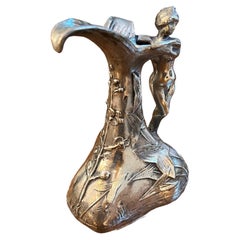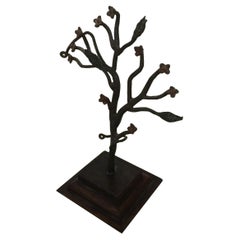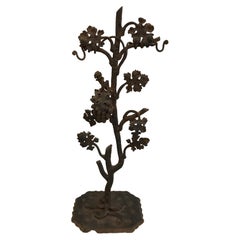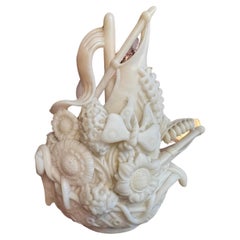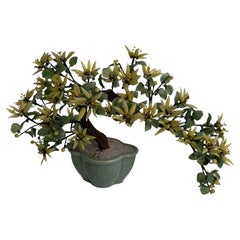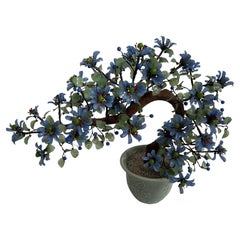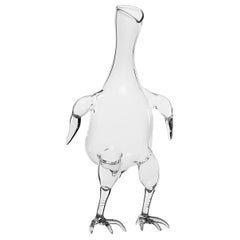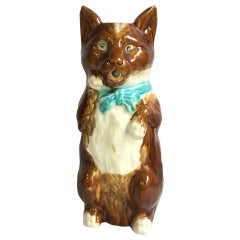Luxurydesignstore Natural Specimens
to
12
12
5
7
4
1
7
7
5
7
7
5
3
2
7
7
7
5
4
Height
to
Width
to
12
12
12
Jar, Jugendstil, Art Nouveau, Liberty, Foundry: Eug. Blot Paris, Design: JOUANT
Located in Ciudad Autónoma Buenos Aires, C
Design: Jules Jouant (1863-1921)
Pitcher sign: Foundry: Eug. Blot Paris / Design: Jouant
Material: Silver plated
Biography
Auguste Jules Alphonse Jouant was born in Paris, Cité Fénelon, in the 9th arrondissement, on June 19, 18632, son of Étienne Alphonse Jouant, carpenter, and Louise Carré.
A student of the Ecole des Beaux-Arts in Paris3, Jules Jouant was one of Auguste Rodin's practitioners. He exhibited the Bust of Prince Gedroyc at the Salon of 1883 and sculpted busts of musicians such as Richard Wagner, Frédéric Chopin or Ludwig van Beethoven. He obtained an honorable mention at the Salon of 1913.
Jules Jouant is renowned for his works of art (vases, dishes, lamp bases, pitchers, candlesticks, table bells, trinket bowls, etc.) typical of the Art Nouveau style, produced in pewter by the Barbedienne founders This link leads to a disambiguation page, Eugène Blot and Ettlinger Frères. He also collaborates with the workshops of the Daum brothers This link returns
He was appointed professor at the Ecole Boulle in Paris.
He is buried in the Cimetière de Passy (2nd division).
Public collections
-Museum of Art and History of Belfort
seaweed, pewter
The Holly, pewter
-Mignard, marble bust, Paris, Manufacture des Gobelins7. Plaster model preserved in Angers in the Maine-et-Loire prefecture8
-Léo Delibes, marble bust, National Opera of Paris9. Plaster model preserved in the town hall of Rochefort (Charente-Maritime)
-Two bas-reliefs, stone...
Category
Antique Early 1900s French Art Nouveau Pitchers
Materials
Metal
Tree with Flowers Sculpture, 1900, Jugendstil, Art Nouveau, Liberty, France
Located in Ciudad Autónoma Buenos Aires, C
We have specialized in the sale of Art Deco and Art Nouveau and Vintage styles since 1982. If you have any questions we are at your disposal.
Pushing the button that reads 'View All...
Category
Antique Early 1900s French Art Nouveau Natural Specimens
Materials
Iron
Vine Tree Sculpture, 1900, Jugendstil, Art Nouveau, Liberty, France
Located in Ciudad Autónoma Buenos Aires, C
We have specialized in the sale of Art Deco and Art Nouveau and Vintage styles since 1982. If you have any questions we are at your disposal.
Pushing the button that reads 'View All...
Category
Antique Early 1900s French Art Nouveau Natural Specimens
Materials
Iron
Flower Boat Sculpture, 1900, Style: Jugendstil, Art Nouveau, Liberty
Located in Ciudad Autónoma Buenos Aires, C
We have specialized in the sale of Art Deco and Art Nouveau and Vintage styles since 1982. If you have any questions we are at your disposal.
Pushing the button that reads 'View All...
Category
Antique Early 1900s French Art Nouveau Natural Specimens
Materials
Marble
Big Yellow Bonsai, Glass and Ceramic
Located in Ciudad Autónoma Buenos Aires, C
We have specialized in the sale of Art Deco and Art Nouveau and Vintage styles since 1982. If you have any questions we are at your disposal.
Pushing the button that reads 'View All ...
Category
Vintage 1980s Japanese Mid-Century Modern Planters, Cachepots and Jardin...
Materials
Ceramic, Art Glass
Big Bonsai, Glass and Ceramic
Located in Ciudad Autónoma Buenos Aires, C
We have specialized in the sale of Art Deco and Art Nouveau and Vintage styles since 1982. If you have any questions we are at your disposal.
Pushing the button that reads 'View All From Seller'. And you can see more objects to the style for sale.
Why are there so many antiques in Argentina?
In the 1880 – 1940 there was a grate wave of immigration encouraged by the periods of war that were taking place.
1st World War took place between 1914 and 1918
2nd World War took place between 1939 and 1945
The immigrants options were New York or Buenos Aires. Tickets were cheap and in Buenos Aires they were welcomed with open arms, as it was a country where everything was still to be done.
Argentina was the country of new opportunities, labour was needed and religious freedom was assured, in many cases the of the family travel first until they were settled and then the rest of the family members join them.
In the immigrant museum “Ellis Island Immigrant Building” in New York you can se the promotional posters of the boats that would take them to a new life.
Between the years 1895 and 1896, Argentina had the highest DGP (gross domestic product) per capita in the world according to the Maddison Historical Statistics index, this situation arose due to the large amount of food being exported to European countries, which were at war.
The Argentinean ships left the port of Buenos Aires with food, but they returned with furniture, clothes and construction elements, (it´s common to see this the old buildings of the historic neighbourhood of San Telmo, the beams with the inscription “Made in England)”, as well as many markets that were built in Buenos Aires, such us the San Telmo Market, whose structure was brought by ship and afterwards assembled in 900 Defensa Street.
With the great influence of European immigrants living in the country, the children of the upper classes travelled to study in France, resulting in the inauguration of “La Maison Argentinienne”, on 27th of June 1928, in the international city of Paris, which hosted many Argentinians that were studying in Frace.
It´s the fourth house to be built after France, Canada and Belgium, being the first Spanish-speaking one. Still in place today (17 Bd Jourdan, 75014, Paris, France). Many of the children of these wealthy families who attended international art exhibitions, museums and art courses abroad, took a keen interest in the European style. This is why Buenos Aires was at the time referred as “The Paris of South America”.
Between the years 1890 and 1920 more than a hundred Palaces were built on Alvear Avenue the most exclusive avenue in Buenos Aires. Today some of these palaces have been transformed into museums, hotels and embassies.
In the year 1936, the Kavanagh building was inaugurated, it was the tallest reinforced concrete building in South America.
During 1994 the American Society of Civil Engineers distinguished it as an “international engineering milestone”, and it´s now considered a World Heritage of Modern Architecture.
At the time was common to hire foreign architects such as Le Corbusier, who visited Buenos Aires/Argentina in 1929 and in 1948 he drew up the blueprints for a house built in La Plata City (which was declared a World Heritage Site).
In 1947, the Hungarian architect Marcelo Breuer designed “Parador Ariston” in the seaside city of Mar del Plata. After an Argentinean student at Harvard University convinced him to come to Argentina. He worked on an urban development project in the Casa Amarilla, area of La Boca.
The Ukrainian architect, Vladimiro Acosta, arrives in Argentina in 1928 and worked as an architect until que moved to Brazil.
Antonio Bonet, a Spanish architect who worked with Le Corbusier in Paris, arrives in Argentina in 1937, where he carried out several architectural works and in 1938 designs the well-known BFK chair.
Andres Kálnay, of Hungarian origin, made around 120 architectural masterpieces, among which the former Munich brewery stands out, he even made the furniture’s design.
The German architect, Walter Gropius, director of the Bauhaus, lived in Argentina, where he wrote articles for “Sur” magazine and founded in Buenos Aires, an architectural firm with Franz Möller, who was also an architect, where he built two houses.
At the same time several famous designers decided to immigrate to Argentina, among them we can find the well-known French designer, Jean-Michel Frank, who arrived in the country in 1940 and also worked for the Rockefeller family.
Special pieces were made, which were sold exclusively in the country, such as the well-known German company “WMF”, who sold their products by catalogue, which were chosen by the ladies of High Society in the list of wedding gifts, as well as the pieces designed by Christofle.
The Swiss sculptor Alberto Giacometti, made special pieces for Argentinean mansions.
In 1904 the first Jansen branch outside Paris was established in Buenos Aires, as the Argentinean clientele demanded a large amount of furniture, from the end of the 19th Century to the mid-20th Century.
In 1970, the brand Rigolleau Argentina made pieces authorised by Lalique.
The brands Maple and Thompson also set up shop in the country.
The French plastic artist, Marcel Duchamp moved to Argentina in 1918-1919.
Glass signed Gallé, Charder, Leverre, Schneider, Muller and other French firms. They were bought in flower shops and were given to ladies with beautiful floral arrangements.
Some furniture manufacturers travelled to international fairs and bough the patterns to produce the furniture in Argentina, such as the furniture firm Englander and Bonta, who bought the patterns ins Italy.
It is worth mentioning that in Argentina we have the largest Community of Italians outside...
Category
Vintage 1980s Japanese Mid-Century Modern Planters, Cachepots and Jardin...
Materials
Art Glass, Ceramic
Pair of Bonsai, Glass and Ceramic, 1980
Located in Ciudad Autónoma Buenos Aires, C
We have specialized in the sale of Art Deco and Art Nouveau and Vintage styles since 1982. If you have any questions we are at your disposal.
Pushing the button that reads 'View All ...
Category
Vintage 1980s Japanese Mid-Century Modern Planters, Cachepots and Jardin...
Materials
Ceramic, Art Glass
Bonsai Blue 1980, Glass and Ceramic
Located in Ciudad Autónoma Buenos Aires, C
We have specialized in the sale of Art Deco and Art Nouveau and Vintage styles since 1982. If you have any questions we are at your disposal.
Pushing the button that reads 'View All From Seller'. And you can see more objects to the style for sale.
Why are there so many antiques in Argentina?
In the 1880 – 1940 there was a grate wave of immigration encouraged by the periods of war that were taking place.
1st World War took place between 1914 and 1918
2nd World War took place between 1939 and 1945
The immigrants options were New York or Buenos Aires. Tickets were cheap and in Buenos Aires they were welcomed with open arms, as it was a country where everything was still to be done.
Argentina was the country of new opportunities, labour was needed and religious freedom was assured, in many cases the of the family travel first until they were settled and then the rest of the family members join them.
In the immigrant museum “Ellis Island Immigrant Building” in New York you can se the promotional posters of the boats that would take them to a new life.
Between the years 1895 and 1896, Argentina had the highest DGP (gross domestic product) per capita in the world according to the Maddison Historical Statistics index, this situation arose due to the large amount of food being exported to European countries, which were at war.
The Argentinean ships left the port of Buenos Aires with food, but they returned with furniture, clothes and construction elements, (it´s common to see this the old buildings of the historic neighbourhood of San Telmo, the beams with the inscription “Made in England)”, as well as many markets that were built in Buenos Aires, such us the San Telmo Market, whose structure was brought by ship and afterwards assembled in 900 Defensa Street.
With the great influence of European immigrants living in the country, the children of the upper classes travelled to study in France, resulting in the inauguration of “La Maison Argentinienne”, on 27th of June 1928, in the international city of Paris, which hosted many Argentinians that were studying in Frace.
It´s the fourth house to be built after France, Canada and Belgium, being the first Spanish-speaking one. Still in place today (17 Bd Jourdan, 75014, Paris, France). Many of the children of these wealthy families who attended international art exhibitions, museums and art courses abroad, took a keen interest in the European style. This is why Buenos Aires was at the time referred as “The Paris of South America”.
Between the years 1890 and 1920 more than a hundred Palaces were built on Alvear Avenue the most exclusive avenue in Buenos Aires. Today some of these palaces have been transformed into museums, hotels and embassies.
In the year 1936, the Kavanagh building was inaugurated, it was the tallest reinforced concrete building in South America.
During 1994 the American Society of Civil Engineers distinguished it as an “international engineering milestone”, and it´s now considered a World Heritage of Modern Architecture.
At the time was common to hire foreign architects such as Le Corbusier, who visited Buenos Aires/Argentina in 1929 and in 1948 he drew up the blueprints for a house built in La Plata City (which was declared a World Heritage Site).
In 1947, the Hungarian architect Marcelo Breuer designed “Parador Ariston” in the seaside city of Mar del Plata. After an Argentinean student at Harvard University convinced him to come to Argentina. He worked on an urban development project in the Casa Amarilla, area of La Boca.
The Ukrainian architect, Vladimiro Acosta, arrives in Argentina in 1928 and worked as an architect until que moved to Brazil.
Antonio Bonet, a Spanish architect who worked with Le Corbusier in Paris, arrives in Argentina in 1937, where he carried out several architectural works and in 1938 designs the well-known BFK chair.
Andres Kálnay, of Hungarian origin, made around 120 architectural masterpieces, among which the former Munich brewery stands out, he even made the furniture’s design.
The German architect, Walter Gropius, director of the Bauhaus, lived in Argentina, where he wrote articles for “Sur” magazine and founded in Buenos Aires, an architectural firm with Franz Möller, who was also an architect, where he built two houses.
At the same time several famous designers decided to immigrate to Argentina, among them we can find the well-known French designer, Jean-Michel Frank, who arrived in the country in 1940 and also worked for the Rockefeller family.
Special pieces were made, which were sold exclusively in the country, such as the well-known German company “WMF”, who sold their products by catalogue, which were chosen by the ladies of High Society in the list of wedding gifts, as well as the pieces designed by Christofle.
The Swiss sculptor Alberto Giacometti, made special pieces for Argentinean mansions.
In 1904 the first Jansen branch outside Paris was established in Buenos Aires, as the Argentinean clientele demanded a large amount of furniture, from the end of the 19th Century to the mid-20th Century.
In 1970, the brand Rigolleau Argentina made pieces authorised by Lalique.
The brands Maple and Thompson also set up shop in the country.
The French plastic artist, Marcel Duchamp moved to Argentina in 1918-1919.
Glass signed Gallé, Charder, Leverre, Schneider, Muller and other French firms. They were bought in flower shops and were given to ladies with beautiful floral arrangements.
Some furniture manufacturers travelled to international fairs and bough the patterns to produce the furniture in Argentina, such as the furniture firm Englander and Bonta, who bought the patterns ins Italy.
It is worth mentioning that in Argentina we have the largest Community of Italians outside...
Category
Vintage 1980s Japanese Mid-Century Modern Planters, Cachepots and Jardin...
Materials
Art Glass, Ceramic
Bonsai Pink 1980, Glass and Wood
Located in Ciudad Autónoma Buenos Aires, C
We have specialized in the sale of Art Deco and Art Nouveau and Vintage styles since 1982. If you have any questions we are at your disposal.
Pushing the button that reads 'View All ...
Category
Vintage 1980s Japanese Mid-Century Modern Planters, Cachepots and Jardin...
Materials
Art Glass, Wood
Pair of Bonsai 1980, Glass and Ceramic
Located in Ciudad Autónoma Buenos Aires, C
We have specialized in the sale of Art Deco and Art Nouveau and Vintage styles since 1982. If you have any questions we are at your disposal.
Pushing the button that reads 'View All ...
Category
Vintage 1980s Japanese Mid-Century Modern Planters, Cachepots and Jardin...
Materials
Art Glass, Ceramic
Bonsai 1980, Glass and Wood
Located in Ciudad Autónoma Buenos Aires, C
We have specialized in the sale of Art Deco and Art Nouveau and Vintage styles since 1982. If you have any questions we are at your disposal.
Pushing the button that reads 'View All ...
Category
Vintage 1980s Japanese Mid-Century Modern Planters, Cachepots and Jardin...
Materials
Wood, Art Glass
Hunter with Deer Attributed to Amadeo Gennarelli, Italian, Art Deco
By Amadeo Gennarelli
Located in Ciudad Autónoma Buenos Aires, C
Materials: Silvered bronze and marble
We have specialized in the sale of Art Deco and Art Nouveau and Vintage styles since 1982.If you have any questions we are at your disposal.
Pushing the button that reads 'View All From Seller'. And you can see more objects to the style for sale.
Amedeo (sometimes Amadeo) Gennarelli (1881-1943)
An Italian/French sculptor, he was a pupil of Francesco Jerace...
Category
Vintage 1920s Italian Art Nouveau Natural Specimens
Materials
Marble
Related Items
Contemporary Hand Blown Glass Decanter Gajna Chicken Farm Playful Animal Liquor
By Simone Crestani
Located in Camisano Vicentino, IT
Gajna Decanter
The Gajna Decanter is an extraordinary hand-blown piece by Simone Crestani, part of the imaginative Gajna Wine Collection. With its playf...
Category
21st Century and Contemporary Italian Modern Pitchers
Materials
Glass
$931 / item
H 16.54 in Dm 9.85 in
French Majolica Cat with Mandolin Pitcher with Blue Ribbon, circa 1890
Located in Austin, TX
French Majolica cat with mandolin pitcher with blue ribbon, circa 1890.
Category
Antique 1890s French French Provincial Pitchers
Materials
Majolica, Ceramic, Faience
$1,200
H 9.7 in W 4.8 in D 6.3 in
Cheetah Glazed Ceramic Hand Painted Pitcher Italy 1975
Located in Douglas Manor, NY
3-645 Eye catching hand painted yellow and black Majolica ceramic Cheetah jug/pitcher
A cool accent to any kitchen or to be use as a serving pitcher.
Lovely as part of a ceramic co...
Category
Vintage 1970s Animal Sculptures
Materials
Ceramic
Planet in White and Apple Green, a Unique Art Glass Sculpture by Lena Bergström
By Lena Bergström
Located in London, GB
Planet in White and Apple Green is a unique glass sculptural artwork and centerpiece by the Swedish artist Lena Bergström. This piece is from an ongoing collection of works called th...
Category
2010s Swedish Organic Modern Abstract Sculptures
Materials
Glass, Art Glass, Blown Glass
$6,652
H 13 in W 13.78 in D 13 in
Mexican Pitcher by Los Castillo
By Los Castillo
Located in Mexico City, CDMX
Circa 1960. We offer this Mexican metal and malachite pitcher sporting an amazing handle in a parrot motif by Los Castillo Taxco México. This is an exquisite and monumental pitcher s...
Category
Vintage 1960s Mexican Mid-Century Modern Abstract Sculptures
Materials
Steel
French Art Nouveau Gilded Bronze of a Mermaid Holding a Shell by Louchet Foundry
Located in Sarasota, FL
French Art Nouveau gilt bronze of a mermaid holding a shell. Possibly used as a card tr fonay. Fine detail and casting. Stamped for Louchet, Phearis foundry on the back of the base.
Category
Antique Late 19th Century French Art Nouveau Figurative Sculptures
Materials
Gold, Bronze
$1,650
H 10.5 in W 4.5 in D 3.5 in
Tall Art Nouveau Silver Centerpiece With Glass Bowl, F. Schlesinger Vienna, 1900
By Franz Schlesinger
Located in Vienna, AT
Elegant silver centerpiece on a tall, round, fluted, tiered base on four divided feet with floral decoration, with elongated radial and alternating small diamond-shaped perforations ...
Category
Antique Early 1900s Austrian Art Nouveau Sterling Silver
Materials
Silver
$2,126
H 8.86 in Dm 8.08 in
19th Century French Art Nouveau Stoneware Cider Pitcher with Satyr Handle
Located in Haarlem, NL
Large 19th century Art Nouveau stoneware cider pitcher with a detailed satyr, faun or devil hanging on a tree branche handle.
Unfortunately I know nothin...
Category
Antique Late 19th Century French Art Nouveau Pitchers
Materials
Stoneware
$680 Sale Price
20% Off
H 12.6 in W 8.27 in D 6.3 in
Mid-Century Modern Mexican Petite Pitcher by Los Castillo
By Los Castillo
Located in Mexico City, CDMX
Circa 1960. We offer this Mid-Century Modern Mexican Petite Pitcher sporting an amazing handle in a bird motif by Los Castillo Taxco México. The pitcher Marked Los Castillo Taxco Mex...
Category
Vintage 1960s Mexican Mid-Century Modern Abstract Sculptures
Materials
Precious Stone
Rare French Majolica Rabbit Pitcher, circa 1900
Located in Austin, TX
French Majolica beige pitcher rabbit with a medal 1900, made for the International Exhibition in Paris of 1900.
The pitcher is stamped by the store where he was sold Compagnie Franco...
Category
Antique Early 1900s French Country Pitchers
Materials
Ceramic, Faience, Majolica
French Majolica Rat Pitcher Poet Laval, circa 1900
By Le Poet-Laval 1
Located in Austin, TX
French Majolica Rat Pitcher Poet Laval, circa 1900.
The rat wear a jacket and hold an umbrella.
Category
Antique Early 1900s French Rustic Pitchers
Materials
Ceramic, Faience
Italian Glazed Zoomorphic Ceramic Pitcher by Bruno Gambone 'circa 1970s'
By Bruno Gambone
Located in London, GB
Italian glazed ceramic pitcher in seagull form by Bruno Gambone (circa 1970s). A very rare Bruno Gambone piece never before encountered by this gallery...
Category
Vintage 1970s Italian Animal Sculptures
Materials
Ceramic
$5,226 Sale Price
23% Off
H 9.85 in W 16.15 in D 13.39 in
